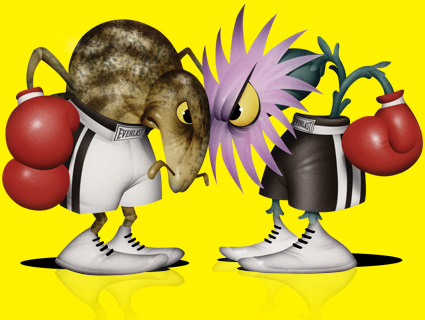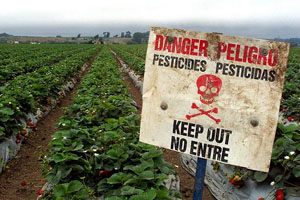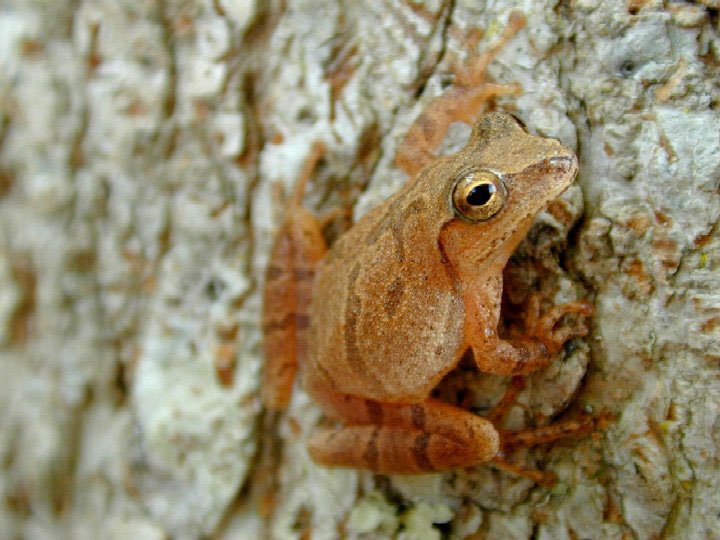
Illustration by Bill Mayer
WE’VE BEEN DRIVING south from Missoula, Montana, for nearly an hour on a torrid August afternoon when Noah Poritz veers his tomato-red pickup truck onto the shoulder of a gravel road and slams on the brakes. The tires slide to an abrupt stop, churning up a cloud of hot dust. Poritz leaps out and surveys the stark landscape. “This is the site,” he declares, making a long, slow sweep across the horizon with his hand. We’re in the heart of the Bitterroot Valley, a 100-mile-long patchwork of dairy farms and cattle ranches, flanked by massive granite peaks. “It is perfect weevil weather today,” says Poritz. “They can’t handle the heat of the soil. When the temperature rises, they climb the plants. When it gets hot is when we scoop them up.”
Poritz is a 52-year-old entomologist who earns his living selling beneficial bugs: critters that munch on invasive pests but leave native flora and fauna alone. Known as biological control, or biocontrol, it’s akin to the age-old trick of scattering live ladybugs on flowerbeds to consume aphids. But there is a key difference: Ladybugs are a temporary fix to rein in a seasonal pest. Poritz targets long-term infestations by invasive organisms. In their native habitats, all weeds and insects have natural enemies that prevent them from becoming pests. But when a species is inadvertently transported to our shores, it leaves its predators behind. Biocontrol reunites predator and prey.
Not only do these beneficial bugs keep harmful pesticides out of sensitive ecosystems, but they’re often cheaper than spraying. Depending on the type of pesticide your pest might require, you could spend between $2,000 and $30,000 annually to spray a 100-acre tract. But for that same size lot, $100 worth of beneficial bugs could do the trick, and they’d reproduce indefinitely, subduing pests year after year at no further cost. Most importantly, biocontrol can work on “low value” land—acreage where it’s not cost-effective or feasible to spray.
Poritz was a technician with the USDA’s Agricultural Research Service when he launched his company with his wife Leona in 1986. “I couldn’t sell any of the insects I worked with if I wanted to move up the career ladder,” he recalls. “So I quit.” Today, Poritz is a leading supplier of weed-killing biocontrol insects—selling more than a dozen insects that combat a variety of invasive plants, such as tansy ragwort, toadflax, leafy spurge, and purple loosestrife.
I’ve come to the Bitterroot Valley to help him collect knapweed root weevils, half-inch-long beetles that originate in Europe and eat only spotted knapweed, an invasive plant indigenous to Eurasia. Because spotted knapweed has no natural predators in the United States, it infests rangelands and marginalizes native grasses that feed wildlife such as elk, deer, antelope, and bison—displacing up to 90 percent of their winter forage—as well as cattle. For every acre that’s infested, ranchers lose about $16 (PDF) in potential income. On wildlands, the damage is roughly $6 per acre.
Spotted knapweed is just one of more than a thousand invasive weeds and bugs in the US. The first likely arrived with early European settlers, but thanks to the global economy, with its airfreight and container ships, their number is rising exponentially. Weed infestations are increasing by 14 percent annually, spreading into Western national parks, forests, and wildlife refuges at a rate of 4,600 acres a day. Invasive pests are jeopardizing nearly half of all species listed as threatened or endangered (PDF). By 2004, a study published in the journal Ecological Economics put damages from weeds and insects alone at $54.6 billion a year (PDF), about half as much as we spend annually on the war in Afghanistan.
Right now, beneficial bugs are at work on roughly 100 million acres of weed-infested land in the US, an area about the size of California. To treat that same acreage would take anywhere from 600,000 to 6 million gallons of herbicides and require multiple doses over consecutive years. There are also dozens of biocontrol programs underway where bug-eating bugs feast on invasive insects.
Poritz yanks a knapweed plant from the ground and snaps open its root. “The root weevil attacks the central taproot,” he explains. “You can crack open those roots and see where they did their damage.” We’re at a 40-acre ranch smothered in knapweed, its violet flowers casting a purple glow across undulating fields. Knapweed root weevils were introduced to the Bitterroot years ago to control the plant, but Poritz says there are more than enough to eventually quash the weed, which is why the landowner gives him permission to harvest the surplus bugs.
For all the talk of a weevil explosion, I’d been expecting something biblical. But my untrained eyes don’t see any weevils. Just then, Poritz plucks one from the top of a wooden fencepost, where it had been sunning itself. “It’s a big honkin’ weevil!” he exclaims. “It’s my favorite bug.” He deposits it in the palm of my left hand. The root weevil is sand-colored and shaped like a kidney bean, with brown spots and a protrusive snout suggestive of an anteater. Exquisite camouflage had rendered it invisible until Poritz showed me what to look for. Suddenly, we are in Weevilville.
Poritz hands me an oversize metal-rimmed net that he engineered with the help of a friend who has a machine shop, and then he demonstrates his sweep-and-scoop weevil-catching technique, which makes him look like he’s dancing a waltz. We slather on sunscreen and don matching wide-brimmed khaki sun hats. The work is mindless and repetitive. Poritz listens to his iPod while trudging through waist-high knapweed and making long, repetitive arcs with his net. In less than an hour, my forearms and back are throbbing. Poritz tells me he was once hospitalized and given intravenous steroids for a “severe allergic reaction and extreme asthma,” possibly triggered by pollen inhaled while collecting and sorting bugs. Today, he’s sniffling and congested after just a few hours of netting weevils.
Because the pickings are ripe, Poritz insists we push through until sunset. A collective cry soon shatters the silence: the high-pitched whine of grasshoppers rubbing their wings together that escalates with the soaring late-afternoon temperatures. After a few clumsy swoops, I empty the contents of my net into a queen-size pillowcase that Poritz had given me earlier. The plump sack hisses and pops, like a wet log tossed onto a roaring campfire. I peek inside, careful not to let any critters escape. It’s a writhing, wiggling bug orgy. An entire root-weevil clan is marching single-file up the inside of the pillowcase, determined to liberate itself from bondage. There are heaps of grasshoppers, too, plus ants, bees, gnats, gall flies, stink bugs, and wasps. My skin starts to itch, a purely psychosomatic response. And then there’s the smell, familiar yet kind of gross: a robust bouquet of freshly cut cucumber with musky overtones.
Full pillowcases are stuffed into a portable electric beer cooler that plugs into the battery of Poritz’s truck. Chilling the weevils ensures they stay alive until we reach his sorting facility. It’s four hours southeast in Bozeman, where he lives in a placid suburb about two miles from his bug shop. A clever vacuum system of screens, fans, and hoses lets him separate beneficial insects from benign bugs, which he sets free. His wife pitches in, doing a final inspection by hand. Poritz thinks our two-day haul in the Bitterroot Valley has reaped 40,000 root weevils. The going rate is 75 cents a bug. He accepts orders online and ships overnight. A hundred weevils are sufficient to start a colony big enough to contain a local knapweed outbreak. “We provide ranchers, county agents, and state and federal land managers an alternative to herbicides,” he says, “and the results are dramatic.”
HISTORIANS HAVE traced some of the earliest known attempts at biocontrol to the Chinese, who dispersed ants into mandarin groves to devour stink bugs and caterpillars in the fourth century. Mauritius was first to enlist a non-native organism: In 1762, the French colony imported mynah birds from India to eat locusts. But most credit a London-born entomologist named Charles Valentine Riley, who was appointed chief of what is now the USDA’s Division of Entomology in 1881, with spawning the modern biocontrol movement.
Around that time, an invasive insect called cottony cushion scale piggybacked on imported acacia saplings from its native habitat in Australia to Southern California, where it assaulted hundreds of thousands of orange trees, decimating the burgeoning citrus industry. In 1888, Riley dispatched a colleague to Australia, instructing him to track down any insects that preyed on cottony cushion scale. He returned with the vedalia beetle, a type of ladybug. Not long after, the USDA released vedalia beetles into California’s orange groves, and within a year they’d crushed the cottony cushion scale.
Nobody is exactly sure how spotted knapweed got to the Bitterroot. One theory blames Eastern European immigrants, who in the mid-1800s might have transported its seeds in containers of alfalfa. But it could have come over to America in the soil ballast of sailing ships, which was dumped upon arrival in port to make room for export cargo.
In any case, it took half a century for spotted knapweed to reach the Intermountain West, where the climate and soil conditions—and a lack of natural predators—let it flourish. By the mid-1970s, spotted knapweed blanketed 4 million acres of western Montana. An ad hoc team of scientists—from Montana State University, the Oregon Department of Agriculture, the University of Idaho, Washington State University, Agriculture and Agri-Food Canada, the USDA, and CABI, a nonprofit research lab based in Switzerland—joined forces to fight the invasion. Botanists knew that knapweed was native to Eurasia, where it was kept in check by a variety of bugs. In 1984, a group of entomologists went there to find out if any of them were “host-specific”—that is, ate nothing but knapweed.
Jim Story, a retired research entomologist from Montana State University and the country’s preeminent spotted knapweed expert, was on the team. He and his colleagues spent five years investigating knapweed feeders in Europe and at quarantined labs back in the States. They had to be very careful. “You certainly wouldn’t want something that feeds on knapweed but turns out later to feed on alfalfa and bananas and barley and everything else,” he says. They evaluated 15 bugs. The winner was the root weevil, because it was the biggest host-specific bug that attacked the plant at its core. In 1988, Story’s group released the first knapweed root weevils in Montana, a batch of 50 adults.
“By 2004, the knapweed had collapsed because the insect had hammered it so hard,” recalls Story. But the weed is still common—part of the reason Poritz is able to stay in business—and knapweed varieties still cost Montana tens of millions of dollars (PDF) a year in land-degradation losses and declines in agriculture and livestock revenues. Story explains: “A 20-year timeline is pretty normal. I truly didn’t know when I started back in ’74 that I would see any results during my career.” Biocontrol programs are a home run a quarter of the time and flop about as often. The other 50 percent show mixed success. But while a winning biocontrol program can take a generation or two to gain a foothold, when it does, its efficacy is virtually guaranteed as its costs wane. “Once the insects are released, they multiply and spread and survive from year to year, providing perpetual control,” says Lincoln Smith, an exotic and invasive weeds research entomologist with the USDA’s Agricultural Research Service.
Chemical mitigation boasts no such advantage. Smith adds, “If you spray a plant, there are seeds in the soil. And those seeds last a long time. So you kill all the plants, and you come back next year, and there are more plants. You need to do that at least three years, and follow up every year. If one plant survives, it’s going to produce enough seed to re-infest your whole field.”
Some insects can mount a resistance to pesticides in fewer than two years, prompting chemical companies to concoct increasingly potent sprays, which leads to ever-more resistant bugs. “Each generation of insecticides is more specific, more expensive, and more difficult to use,” says Norman Leppla, an entomology professor at the University of Florida. “You also have to apply insecticide continually. There is no long-term benefit. It doesn’t matter where you look—environment, climate, production agriculture—we’ve reached the end of our chemical rope.”
It’s harder to gauge the square-mile impact of invasive bugs because they’re peripatetic and seasonal, but they can be just as problematic. Take the emerald ash borer, a small beetle with shimmering green thorax armor. “It came from China on crates,” says Roy Van Driesche, an entomologist at the University of Massachusetts-Amherst, who has coauthored two books on biocontrol. “[It] is killing tens of millions of trees in the Midwest and will soon be nationwide if we don’t find biocontrol agents to lower its density and slow its spread.”
A typical biocontrol program targeting a single pest can cost up to $750,000 a year. Yet—even as invasive weeds are spreading at the aforementioned rate of 14 percent a year—total federal spending against invasives, of which biocontrol is a small part, has flatlined at $1.2 billion. Meanwhile, the big players of the $40 billion global pesticide industry—Dow, Bayer, Syngenta, BASF, and Monsanto—”are able to exert tremendous control through allies in universities, the USDA, through Congress, and through their public relations efforts,” says Poritz.
Biocontrol can be a tough sell, not only because of the uncertain outcome and long time frame, but because the cost is all up front. But Van Driesche says that calculus is “pretty insensitive to the number of acres that ultimately benefit. Let’s say you spend $5 million over 10 years to run a project. If the [biocontrol] release infests 1 million acres, then the cost per acre is $5.” That’s a pittance, compared with pesticides at potentially hundreds of dollars per acre. And biocontrol is essentially free once the beneficial bug establishes itself. One study cites a 23-to-1 benefit-to-cost ratio, even including failed projects. But it does take time—5 to 20 years per project, Van Driesche points out: “There is no way to do a crash project of biocontrol.”
THE ROOT WEEVIL assault on Montana’s spotted knapweed epidemic is an exemplary success and, in terms of acreage, is one of the largest applications of biocontrol in US history. But biocontrol has also begun to rein in the alfalfa weevil and screwworm fly. Chrysolina quadrigemina, a beetle intentionally imported from Australia in the 1940s, has battled Klamath weed (a.k.a. St. John’s wort), which poisons cattle and threatened to wipe out California livestock in the 1930s (PDF). In Texas, the phorid fly is preying on South American fire ants. The Mediterranean yellow starthistle—the most insidious weed in California, where it attacks orchards and vineyards—is up against several species of weevils and fruit flies imported from its homeland. A South American planthopper is targeting water hyacinth, which lowers oxygen levels, causing fish to go belly up.
Biocontrol isn’t without risk. “The biggest mistakes were made by farmers and plantation owners in the 1700s and 1800s who introduced various predacious vertebrates like the mongoose to control rats, which was very damaging to native birds and lizards,” Van Driesche recalls. (Today, the USDA mandates that any imported biocontrol insect must be shown to eat only pests.) A more recent snafu (PDF) occurred when scientists tried to combat spotted knapweed with a fly that laid its eggs inside the knapweed seeds, destroying them. The fly proliferated and became a favorite meal to deer mice. Soon, an overpopulation of deer mice attracted owls, which preyed on the rodents and eventually excreted the seeds in their pellets. The owls became a transport mechanism for spreading knapweed. And when scientists employed an Asian leaf beetle to take on the Eurasian saltcedar—which concentrates salt, poisons everything in its shadow, and has infested more than a million acres and 56 national wildlife refuges—the beetle became too successful, threatening the habitat of the endangered Southwestern willow flycatcher.
And biocontrol isn’t feasible for every pest. If an invasive weed is closely related to a native plant, it’s nearly impossible to find a bug that attacks the pest but not its kin. Other drawbacks are climate and topography: A beneficial bug that excels in Florida may founder in the Southwest, even though its target weed or insect thrives with impunity. Sometimes the population of the beneficial bug stabilizes at too low a level to mitigate the spread of a weed. This happened when the Hyles euphorbiae, a pink-hued hawk moth, was introduced in the 1960s to combat leafy spurge, a Eurasian perennial now present in 19 states and seven national parks. Biocontrol teams have since had to import 13 other insects to join the hawk moth—though the coalition force is making progress against leafy spurge, reducing infestations by up to 90 percent.
Fortunately, as biocontrol bugs are introduced to new ecosystems, they don’t appear to suddenly develop cravings for other kinds of plants or insects. Nor do they jump species—like mad cow disease or the virus that causes swine flu—or morph into some kind of superbug. “They have evolved over eons of time with their host weed, so the likelihood of them deviating is extremely small,” Story assures me.
Still, adaptation works in mysterious ways. Take our old friend the root weevil. In many places, it has vanquished spotted knapweed only to see it replaced by an invasive known as cheatgrass. This is a fairly common problem: Established invaders like spotted knapweed have already wiped out native plants, so biocontrol creates a vacuum often filled by other invasive plants. In other words, it’s hard to put the genie back in the bottle.
I’m confronted with this when, while unpacking my suitcase after returning from my trip with Poritz, I discover a souvenir from my travels: a perfectly intact root weevil clinging to the leg of a pair of blue jeans. The feisty stowaway rears on its hind legs and flails its forward pincers in the air in a menacing fashion, like a boxer throwing jabs. It’s a reminder that insects and weeds are wily vagabonds that can transport themselves across oceans and continents with consequences nobody, not even well-intentioned entomologists, can quite anticipate. “By distributing millions of insects, I am having a macro-impact on the environment,” says Poritz. “You can literally watch a landscape transform after doing biocontrol. It’s not exactly Charles Darwin and the Beagle, but what I do is natural history.”















